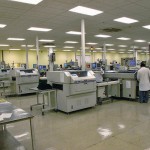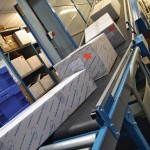Rather than viewing outsourcing as a way to offload unwanted tasks, OEMs should select carefully and maintain a properly managed relationship with their chosen EMS partner.
By Mark Stuart, Business Development Director, The Paragon Electronics Ltd Group, Bedford/UK
Ultimately, outsourcing product manufacturing should improve business performance. Rightly, OEMs go to great lengths to evaluate potential partners. In addition to ensuring that the immediate production requirements can be fulfilled successfully, they should also look for expertise to manage the supply chain effectively, improve processes and production, and respond to future changes. Most OEMs will focus on these aspects rather than looking for the lowest cost proposal. But supplier selection is only the first part of the work that OEMs should expect to do if outsourcing is to deliver its full potential.
Best Foot Forward
Before the project can begin, both companies must work to ensure that manufacturing can transition seamlessly to the EMS partner without suffering delays or process-transfer problems. Typical challenges can include lower than expected initial yield, which usually results when critical information is not documented and therefore not included as part of the product build information. Rushing the handover can encourage these types of problems. Hence the OEM must ensure that the assembler has enough information to build the product properly.
Ensuring up-to-date documentation as part of a fully detailed build pack, therefore, is the most important first action for a new outsourcing partnership. Other important handover activities include checking that the BOMs are correctly interpreted to ensure consistent component specifications, as well as making sure that the assembly and test processes are understood. At this stage, structured dialogue between the two companies is vital to help the EMS company to absorb the commonly found ‘unwritten’ details such as any aspects of the design that are more sensitive to variations, fine-tuning of process settings, or common failure modes seen during testing.
Making the effort to ensure that the EMS provider understands as much as possible about the product will contribute to a controlled handover achieving high initial yield and good product quality.
Working with its customers to complete this stage successfully, Paragon EMS has established a set of standardised sign-off procedures to make sure that all of the information necessary to build a given product is shared and understood, and fully up to date. Once production is up and running, a detailed review is then recommended so that any issues can be identified and solved. As best practice, Paragon always presents a full NPI report immediately after the first build.
Feedback from the Coal Face
The focus for both companies can then move onto continuous improvement. Examples include identifying alternative components, where appropriate, to improve price or availability. This is an area where the EMS partner should be able to contribute high levels of expertise in disciplines such as component engineering and purchasing. The value here lies not only in lower component prices, but also in reducing exposure to lead-time fluctuations and anticipating supply difficulties such as obsolescence announcements.
Going forward, both parties must exchange information regularly. It is equally vital for the EMS company to keep the OEM informed of production status, just as it needs to receive timely marketing and sales forecasts for optimal management of the material pipeline and assembly capacity. At its most effective, this dialogue allows the manufacturer to avoid overstock situations by promptly communicating downturns in requirements; in effect ‘replacing’ inventory with information. As an example, Paragon responds quickly to market intelligence received from its OEM partners by using its agile EDI based purchasing system to push and pull the material supply chain as customers’ requirements change.
Valuable communication from the EMS company back to the OEM should include regular reports covering issues such as component obsolescence and life-stage of key components. This provides vital intelligence for the OEM to ensure continuous availability of suitable components. Paragon helps with this by providing inventory reports detailing raw components, WIP and finished-goods stock.
Monitoring of material lead times also helps the OEM and the EMS company work together to optimise any agreed pipelining and buffering in relation to the lead-time and product replenishment needs for any given component.
Managing Offshore EMS
With these procedures and communication channels operating properly, the EMS partner is able to play a full role in delivering improvements to production and delivery of the product. Achieving this ideal, however, requires great attention to detail, even when working with a local or regional company. It can be even more difficult to achieve when considering moving manufacturing offshore.
Paragon’s approach to manufacturing services delivers a ‘best fit manufacturing’ approach that decouples the supply chain management tasks from the place of assembly. A centralised hub focuses on procurement and kitting, while production is assigned to group-owned manufacturing sites in the UK and Central Europe, as well as a select number of accredited manufacturing partners based internationally. This structure gives the added flexibility to use assembly sites on the basis of capabilities, local labour costs or proximity to important markets.
Hence, although working with an offshore EMS partner can present even more acute communication challenges than using a manufacturer closer to home, this decoupled structure provides a built-in solution. Overall, the key to successful outsourcing – whether local or offshore – is communication.
EPPE402
Communication is the key
Overall, the key to successful outsourcing – whether local or offshore – is communication. Paragon’s approach to manufacturing services delivers a ‘best fit manufacturing’ approach that decouples the supply chain management tasks from the place of assembly. A centralised hub focuses on procurement and kitting, while production is assigned to group-owned manufacturing sites in the UK and Central Europe, as well as a select number of accredited manufacturing partners based internationally. This structure gives the added flexibility to use assembly sites on the basis of capabilities, local labour costs or proximity to important markets.
Share:











